Higher Education for Sustainability: A Bibliometric Approach—What, Where and Who Is Doing Research in This Subject?
Abstract
:1. Introduction
- (1)
- What is the reality that has been observed in terms of research in the field of higher education for sustainability—What?
- (2)
- Which countries and institutions have contributed the most to the study of higher education for sustainability—Where?
- (3)
- Who has contributed more in terms of research on higher education for sustainability—Who?
2. Methodology
- -
- the number of publications on “Higher Education for Sustainability” over the period under review
- -
- the countries that publish the most in this area
- -
- the institutions that most publish in this area
- -
- the journals that most publish in this area
- -
- the areas in which authors publish the most
- -
- the authors who publish the most
3. Results Analysis and Discussion
4. Conclusions
Author Contributions
Funding
Institutional Review Board Statement
Informed Consent Statement
Data Availability Statement
Conflicts of Interest
References
- Hediger, W. Weak and strong sustainability, environmental conservation and economic growth. Nat. Resour. Model. 2006, 19, 359–394. [Google Scholar] [CrossRef]
- Sidiropoulos, E. Education for sustainability in business education programs: A question value. J. Clean. Prod. 2014, 85, 472–475. [Google Scholar] [CrossRef]
- Kates, R.; Clark, W.; Corell, R.; Hall, M.; Jaeger, C.; Lowe, L.; McCarthy, J.; Schellnhuber, H.; Bolin, B.; Dickson, N.; et al. Sustainability Science. Science 2001, 292, 641–642. [Google Scholar] [CrossRef] [PubMed]
- Disterheft, A.; Caeiro, S.; Azeiteiro, U.; Leal Filho, W. Sustainability science and education for sustainability development in universities: Away for transition. In Sustainability Assessment Tools in Higher Education Institutions; Caeiro, S., Filho, W.L., Jabbour, C., Azeiteiro, U.M., Eds.; Springer: Berlin/Heidelberg, Germany, 2013; Chapter 1; pp. 3–28. [Google Scholar]
- Juárez-Nájera, M. Exploring Sustainable Behavior Structure in Higher Education: A Social-Psychology Confirmatory Approach; Springer: Berlin/Heidelberg, Germany, 2015. [Google Scholar]
- Leal Filho, W.; Manolas, E.; Pace, P. The future we want: Key issues on sustainable development in higher education after Rio and the UN decade of education for sustainable development. Int. J. Sustain. High. Educ. 2015, 16, 112–129. [Google Scholar] [CrossRef] [Green Version]
- Leal Filho, W. About the role of the universities and their contribution to sustainable development. High. Educ. Policy 2011, 24, 427–438. [Google Scholar] [CrossRef]
- Reunamo, J.; Pipere, A. Doing research on education for sustainable development. Int. J. Sustain. High. Educ. 2011, 12, 110–124. [Google Scholar] [CrossRef]
- Wright, T.; Wilton, H. Facilities management director´s conceptualizations of sustainability in higher education. J. Clean. Prod. 2012, 31, 118–125. [Google Scholar] [CrossRef]
- Wright, T.; Horst, N. Exploring the ambiguity; what faculty leaders really think of sustainability in higher education. Int. J. Sustain. High. Educ. 2013, 14, 209–227. [Google Scholar] [CrossRef]
- Disterheft, A.; Caeiro, S.; Leal Filho, W.; Azeiteiro, U. The INDICARE-model—Measuring and caring about participation in higher education’s sustainability assessment. Ecol. Indic. 2016, 63, 172–186. [Google Scholar] [CrossRef]
- Leal Filho, W.; Jim Wu, Y.-C.; Brandli, L.; Avila, L.; Azeiteiro, U.; Caeiro, S.; Madruga, L. Identifying and overcoming obstacles to the implementation of sustainable development at universities. J. Integr. Environ. Sci. 2017, 14, 93–108. [Google Scholar] [CrossRef]
- Aleixo, A.; Leal, S.; Azeiteiro, U. Conceptualization of sustainable higher education institutions, roles, barriers, and challenges for sustainability: An exploratory srudy in Portugal. J. Clean. Prod. 2018, 172, 1664–1673. [Google Scholar] [CrossRef]
- Farinha, C.; Azeiteiro, U.; Caeiro, S. Education for sustainable development in Portuguese universities: The key actors’ opinions. Int. J. Sustain. High. Educ. 2018, 19, 912–941. [Google Scholar] [CrossRef]
- Aleixo, A.; Azeiteiro, U.; Leal, S. The implementation of sustainability practices in Portuguese higher education institutions. Int. J. Sustain. High. Educ. 2018, 19, 146–178. [Google Scholar] [CrossRef]
- Aleixo, A.; Azeiteiro, U.; Leal, S. Are the sustainable development goals being implemented in the Portuguese higher education formative offer? Int. J. Sustain. High. Educ. 2020, 21, 336–352. [Google Scholar] [CrossRef]
- Tejedor, G.; Segalàs, J.; Rosas, M. Transdisciplinarity in higher education for sustainability: How discourses are approached in engineering education. J. Clean. Prod. 2018, 175, 29–37. [Google Scholar] [CrossRef] [Green Version]
- Risopoulos-Pichler, F.; Daghofer, F.; Steiner, G. Competences for Solving Complex Problems: A Cross-Sectional Survey on Higher Education for Sustainability Learning and Transdisciplinarity. Sustainability 2020, 12, 6016. [Google Scholar] [CrossRef]
- Zhu, W.; Wang, Z. The collaborative networks and thematic trends of research on purchasing and supply management for environmental sustainability: A bibliometric review. Sustainability 2018, 10, 1510. [Google Scholar] [CrossRef] [Green Version]
- Rosa, A.; Chimendes, V.; Silva, L.; Mello, C. Inovação e métricas para a inovação: Uma análise bibliométrica das produções relevantes de 2004 a 2014. In Gestão do Conhecimento e Inovação, Mendonça, L., Org.; Editora Poisson: Belo Horizonte, Brasil, 2017; Volume 4, pp. 7–15. [Google Scholar]
- Fusco, G. Twenty Years of Common Agricultural Policy in Europe: A Bibliometric Analysis. Sustainability 2021, 13, 10650. [Google Scholar] [CrossRef]
- Donthu, N.; Kumar, S.; Mukherjee, D.; Pandey, N.; Lim, W. How to conduct a bibliometric analysis: An overview and guidelines. J. Bus. Res. 2021, 133, 285–296. [Google Scholar] [CrossRef]
- SDSN Australia/Pacific. Getting Started with the SDGs in Universities: A Guide for Universities, Higher Education Institutions, and the Academic Sector; Australia, New Zealand and Pacific Edition; Sustainable Development Solutions Network: Melbourne, Australia, 2017. [Google Scholar]
- Hernández-Diaz, P.; Polanco, J.-A.; Escobar-Sierra, M.; Leal Filho, W. Holistic integration of sustainability at universities: Evidences from Colombia. J. Clean. Prod. 2021, 305, 127145. [Google Scholar] [CrossRef]
- Leal Filho, W.; Wall, T.; Salvia, A.; Frankenberger, F.; Hindley, A.; Mifsud, M.; Brandli, L.; Will, M. Trends in scientific publishing on sustainability in higher education. J. Clean. Prod. 2021, 296, 126569. [Google Scholar] [CrossRef]
- Leal Filho, W.; Dinis, M.; Sivapalan, S.; Begum, H.; Ng, T.; Al-Amin, A.; Alam, G.; Sharifi, A.; Salvia, A.; Kalsoom, A.; et al. Sustainability practices at higher education institutions in Asia. Int. J. Sustain. High. Educ. 2021, in press. [CrossRef]
- Leal Filho, W.; Frankenberger, F.; Salvia, A.; Azeiteiro, U.; Alves, F.; Castro, P.; Will, M.; Platje, J.; Lovren, V.; Brandli, L.; et al. A framework for the implementation of the Sustainable Development Goals in university programmes. J. Clean. Prod. 2021, 299, 126915. [Google Scholar] [CrossRef]
- Griebeler, J.; Brandli, L.; Salvia, A.; Leal Filho, W.; Reginatto, G. Sustainable development goals: A framework for deploying indicators for higher education institutions. Int. J. Sustain. High. Educ. 2021, in press. [CrossRef]
- Tominaga, L.; Martins, V.; Rampasso, I.; Anholon, R.; Silva, D.; Pinto, J.; Leal Filho, W.; Lima Junior, F. Critical analysis of engineering education focused on sustainability in supply chain management: An overview of Brazilian higher education institutions. Int. J. Sustain. High. Educ. 2021, in press. [CrossRef]
- Zanitt, J.; Rampasso, I.; Quelhas, O.; Serafim, M.; Leal Filho, W.; Anholon, R. Analysis of sustainability insertion in materials selection courses of engineering undergraduate programmes. Int. J. Sustain. High. Educ. 2021, in press. [CrossRef]
- Leal Filho, W.; Price, E.; Wall, T.; Shield, C.; Azeiteiro, U.; Mifsud, M.; Brandli, L.; Farinha, C.; Caeiro, S.; Salvia, A.; et al. COVID-19: The impact of a global crisis on sustainable development teaching. Environ. Dev. Sustain. 2021, 23, 11257–11278. [Google Scholar] [CrossRef]
- Leal Filho, W. COVID-19, sustainable development and higher education: Towards a recovery path. Int. J. Sustain. High. Educ. 2021, 22, 138–141. [Google Scholar] [CrossRef]
- Lozano, R.; Bautista-Puig, N.; Barreiro-Gen, M. Developing a sustainability competences paradigm in Higher Education or a White Elephant? Sustain. Dev. 2022, in press. [CrossRef]
- Lozano, R.; Barreiro-Gen, M.; Pietikainen, J.; Gago-Cortes, C.; Favi, C.; Jimenez Munguia, M.; Monus, F.; Simão, J.; Benayas, J.; Desha, C.; et al. Adopting sustainability competence-based education in academic disciplines: Insights from 13 higher education institutions. Sustain. Dev. 2021, in press. [CrossRef]
- Lozano, R.; Barreiro-Gen, M.; Lozano, F.; Sammalisto, K. Teaching sustainability in European higher education institutions: Assessing the connections between competences and pedagogical approaches. Sustainability 2019, 11, 1602. [Google Scholar] [CrossRef] [Green Version]
- Lozano, R.; Merrill, M.; Sammalisto, K.; Ceulemans, K.; Lozano, F. Connecting competences and pedagogical approaches for sustainable development in higher education: A literature review and framework proposal. Sustainability 2017, 9, 1889. [Google Scholar] [CrossRef] [Green Version]
- Ceulemans, K.; Scarff Seatter, C.; Molderez, I.; Van Liedekerke, L.; Lozano, R. Unfolding the competences of the sustainability Reporting Process in higher education: A case study in the university of British Columbia. World Sustain. Ser. 2020, 1043–1070. [Google Scholar]
- Blanco-Portela, N.; Pertierra, L.; Benayas, J.; Lozano, R. Sustainability leaders’ perceptions on the drivers for and the barriers to the integration of sustainability in Latin American higher education institutions. Sustainability 2018, 10, 2954. [Google Scholar] [CrossRef] [Green Version]
- Blanco-Portela, N.; Benayas, J.; Pertierra, L.; Lozano, R. Towards the integration of sustainability in higher education institutions: A review of drivers of and barriers to organizational change and their comparison against those found of companies. J. Clean. Prod. 2017, 166, 563–578. [Google Scholar] [CrossRef]
- Lozano, R.; Barreiro-Gen, M. Analysing the factors affecting the incorporation of sustainable development into European higher education institutions’curricula. Sustain. Dev. 2019, 27, 965–975. [Google Scholar] [CrossRef]
- Findler, F.; Schonherr, N.; Lozano, R.; Reider, D.; Martinuzzi, A. The impacts of higher education institutions on sustainable development: A review and conceptualization. Int. J. Sustain. High. Educ. 2019, 20, 23–38. [Google Scholar] [CrossRef] [Green Version]
- Findler, F.; Schonherr, N.; Lozano, R.; Stacherl, B. Assessing the impacts of higher education institutions on sustainable development—An analysis of tools and indicators. Sustainability 2019, 11, 59. [Google Scholar] [CrossRef] [Green Version]
- Lozano, R.; Barreiro-Gen, M. Disrupting the brave new world: COVID-19 effects on organizations’ sustainability efforts. J. Organ. Change Manag. 2020, 34, 613–628. [Google Scholar] [CrossRef]
- Leal Filho, W.; Shield, C.; Paço, A.; Mifsus, M.; Ávila, L.; Brandli, L.; Molthan-Hill, P.; Pace, P.; Azeiteiro, U.; Vargas, V.; et al. Sustainable development goals and sustainability teaching at universities: Falling behind or getting ahead of the pack? J. Clean. Prod. 2019, 232, 285–294. [Google Scholar] [CrossRef] [Green Version]
- Caeiro, S.; Azeiteiro, U.M. Sustainability assessment in higher education institutions. Sustainability 2020, 12, 3433. [Google Scholar] [CrossRef] [Green Version]
- Aleixo, A.; Leal, S.; Azeiteiro, U.M. Higher education students’ perceptions of sustainable development in Portugal. J. Clean. Prod. 2021, 327, 129429. [Google Scholar] [CrossRef]
- Figueiredo, C.; Azeiteiro, U.; García-Vinuesa, A.; Carvalho, S. Campus decarbonization: Students’ perceptions for reducing meat consumption in a Portuguese university. Sustainability 2021, 13, 6048. [Google Scholar] [CrossRef]
- Do Paço, A.; Azeiteiro, U. Living labs for education for sustainable development in the context of higher education: Identifying triggers and drivers of development in the Portuguese Universities. In Higher Education Institutions in a Global Warming World: The Transition of Higher Education Institutions to a Low Carbon Economy; Azeiteiro, U.M., Filho, W.L., Davim, J.P., Eds.; River Publishers: Aalborg, Denmark, 2017; pp. 155–170. [Google Scholar]
- Aleixo, A.; Leal, S.; Filho, W.L.; Mendes, S.; Azeiteiro, U.M. Rankings and sustainability in Portuguese Higher Education Institutions: A descriptive analysis. In Higher Education Institutions in a Global Warming World: The Transition of Higher Education Institutions to a Low Carbon Economy; Azeiteiro, U.M., Filho, W.L., Davim, J.P., Eds.; River Publishers: Aalborg, Denmark, 2017; pp. 97–112. [Google Scholar]
- Shephard, K.; Kalsoom, Q.; Gupta, R.; Probst, L.; Gannon, P.; Stanthakumar, V.; Ndukwe, I.G.; Jowet, T. Exploring the relationship between dispositions to think critically and sustainability concern in HESD. Int. J. Sustain. High. Educ. 2021, 22, 1166–1185. [Google Scholar] [CrossRef]
- Shephard, K.; Furnari, M. Exploring what university teachers think about education for sustainability. Stud. High. Educ. 2013, 38, 1577–1590. [Google Scholar] [CrossRef]
- Shephard, K. Higher education for sustainable development: Learning gains or learning losses? Int. Perspect. High. Educ. Res. 2021, 14, 117–130. [Google Scholar]
- Shephard, K.; Brown, K. How democratic is higher education for sustainable development? Discourse 2017, 38, 755–767. [Google Scholar] [CrossRef]
- Shephard, K.; Dulgar, P. Why It Matters How We Frame “Education” in Education for Sustainable Development. Appl. Environ. Educ. Commun. 2015, 14, 137–148. [Google Scholar] [CrossRef]
- Shephard, K.; Rieckmann, M.; Barth, M. Seeking sustainability competence and capability in the ESD and HESD literature: An international philosophical hermeneutic analysis. Environ. Educ. Res. 2019, 25, 532–547. [Google Scholar] [CrossRef]
- Shephard, K.; Brown, K.; Guiney, T. Researching the professional-development needs of community-engaged scholars in a New Zealand university. Sustainability 2017, 9, 1249. [Google Scholar] [CrossRef] [Green Version]
- Holdsworth, S.; Sandri, O.; Thomas, I.; Wong, P.; Chester, A.; McLaughlin, P. The use of the theory of planned behaviour to assess graduate attributes for sustainability. Environ. Educ. Res. 2020, 26, 275–295. [Google Scholar] [CrossRef]
- Holdsworth, S.; Sandri, O.; Thomas, I.; Wong, P.; Chester, A.; McLaughlin, P. The assessment of graduate sustainability attributes in the workplace: Potential advantages of using the theory of planned behaviour (TPB). J. Clean. Prod. 2019, 238, 117929. [Google Scholar] [CrossRef]
- Sandri, O.; Holdsworth, S.; Thomas, I. Vignette question design for the assessment of graduate sustainability learning outcomes. Environ. Educ. Res. 2018, 24, 406–426. [Google Scholar] [CrossRef]
- Sandri, O.; Holdsworth, S.; Thomas, I. Assessing graduate sustainability capability post-degree completion: Why is it important and what are the challenges? Int. J. Sustain. High. Educ. 2018, 19, 2–14. [Google Scholar] [CrossRef]
- Thomas, I. Influences on career choice: Considerations for the environmental profession. Environ. Pract. 2017, 19, 115–127. [Google Scholar] [CrossRef]
- Thomas, I.; Depasquale, J. Connecting curriculum, capabilities and careers. Int. J. Sustain. High. Educ. 2016, 17, 738–755. [Google Scholar] [CrossRef]
- Côrtes, P.; Rodrigues, R. A bibliometric study on “education for sustainability”. Braz. J. Sci. Technol. 2016, 3, 8. [Google Scholar] [CrossRef] [Green Version]
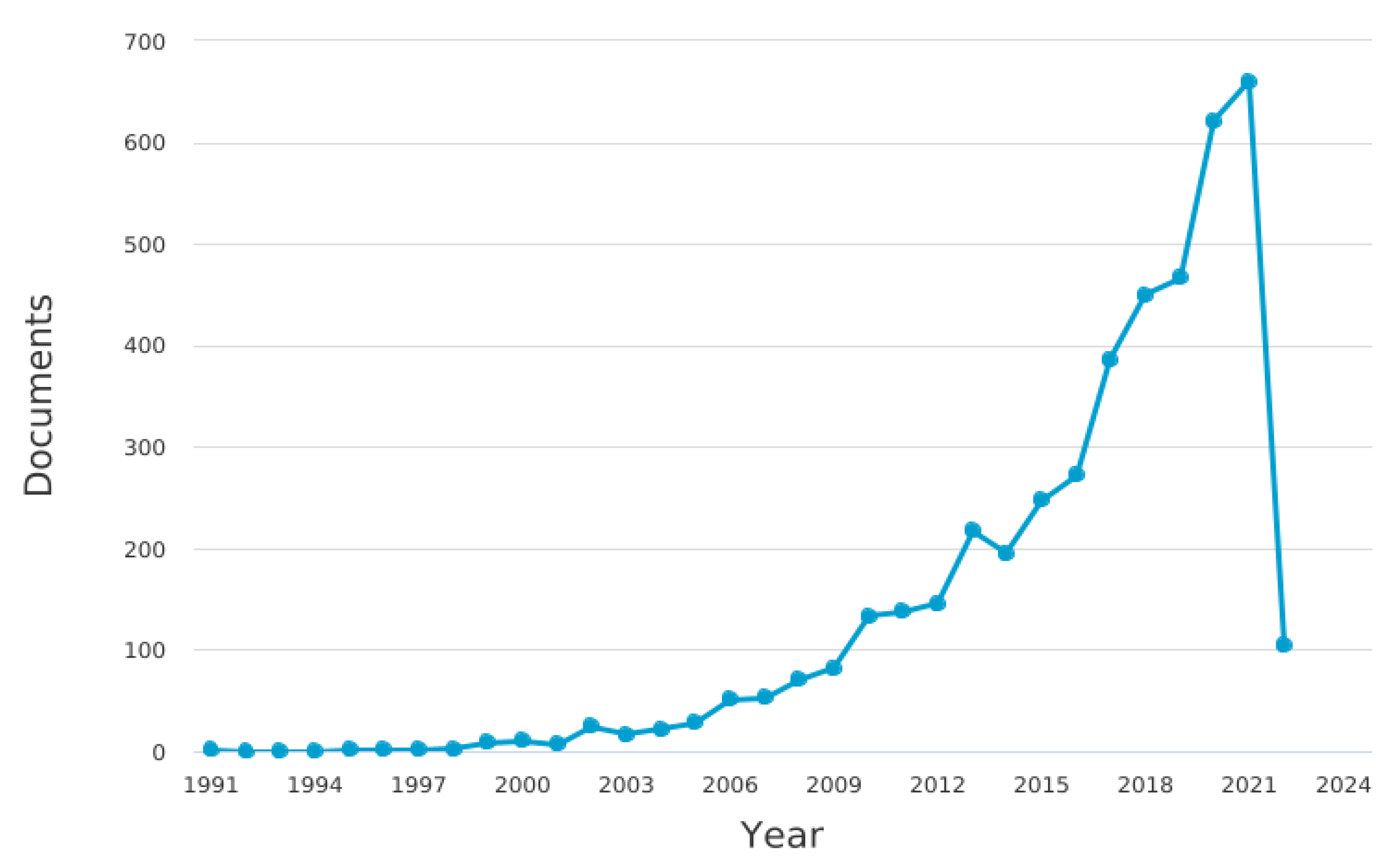
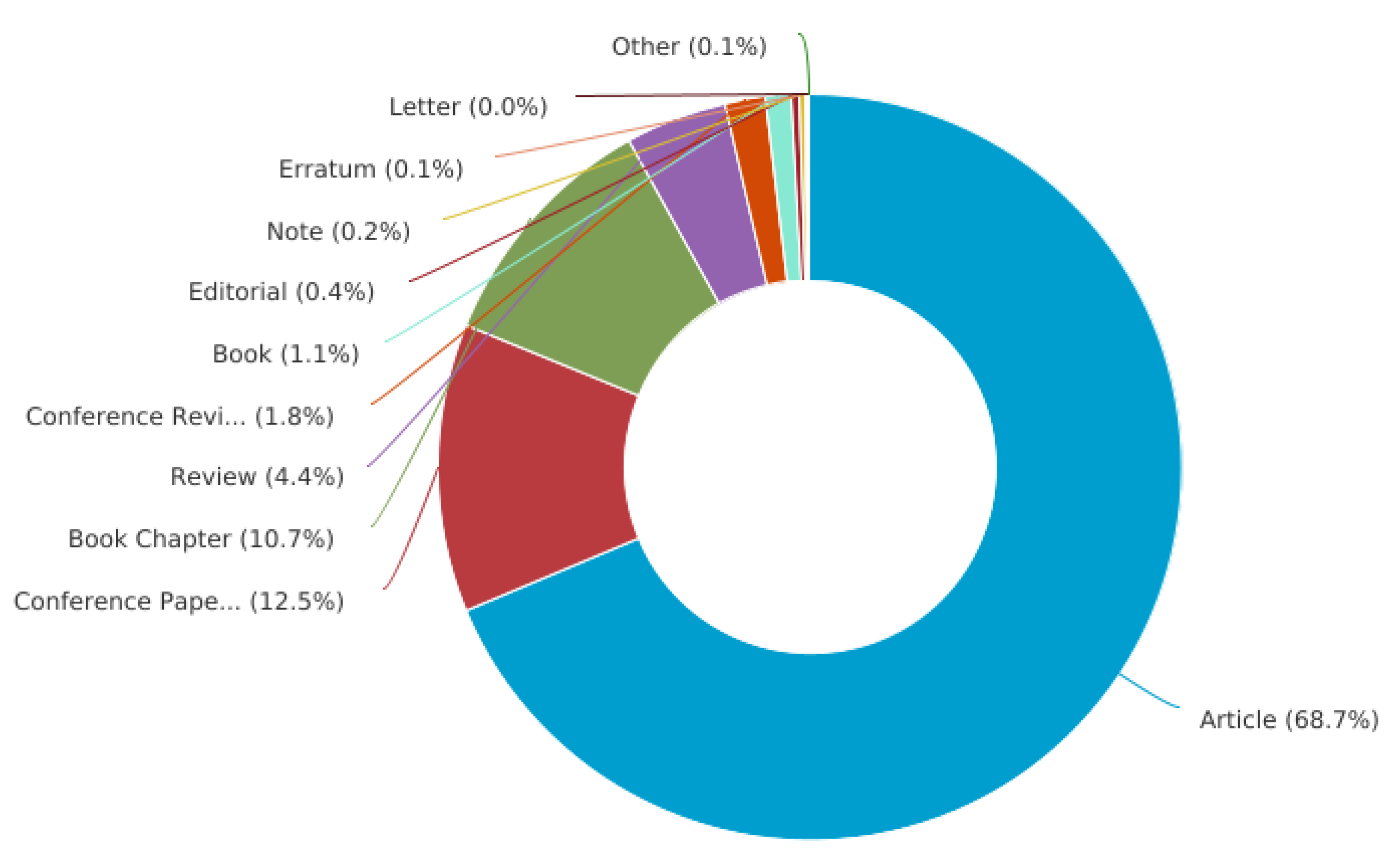
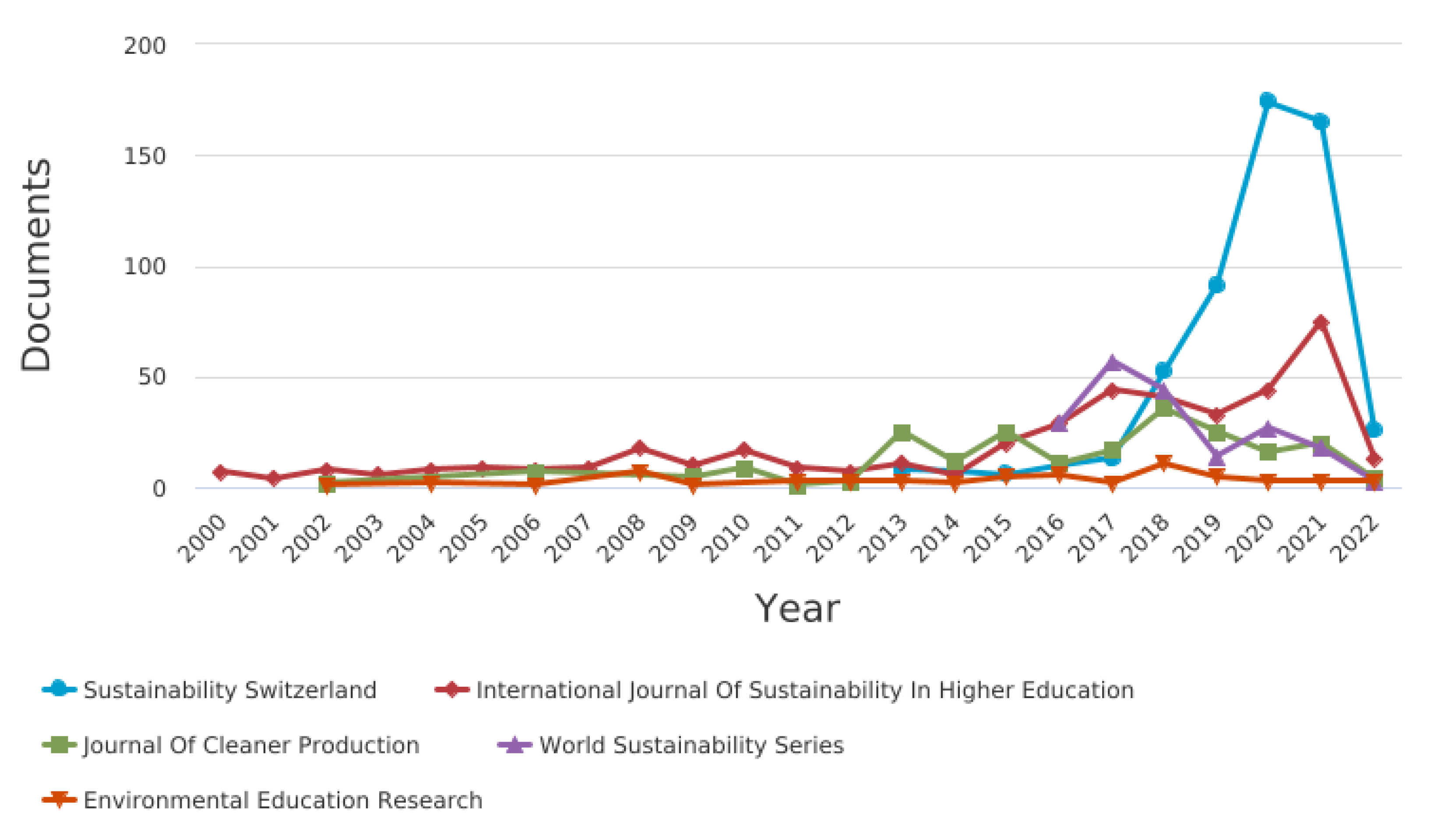
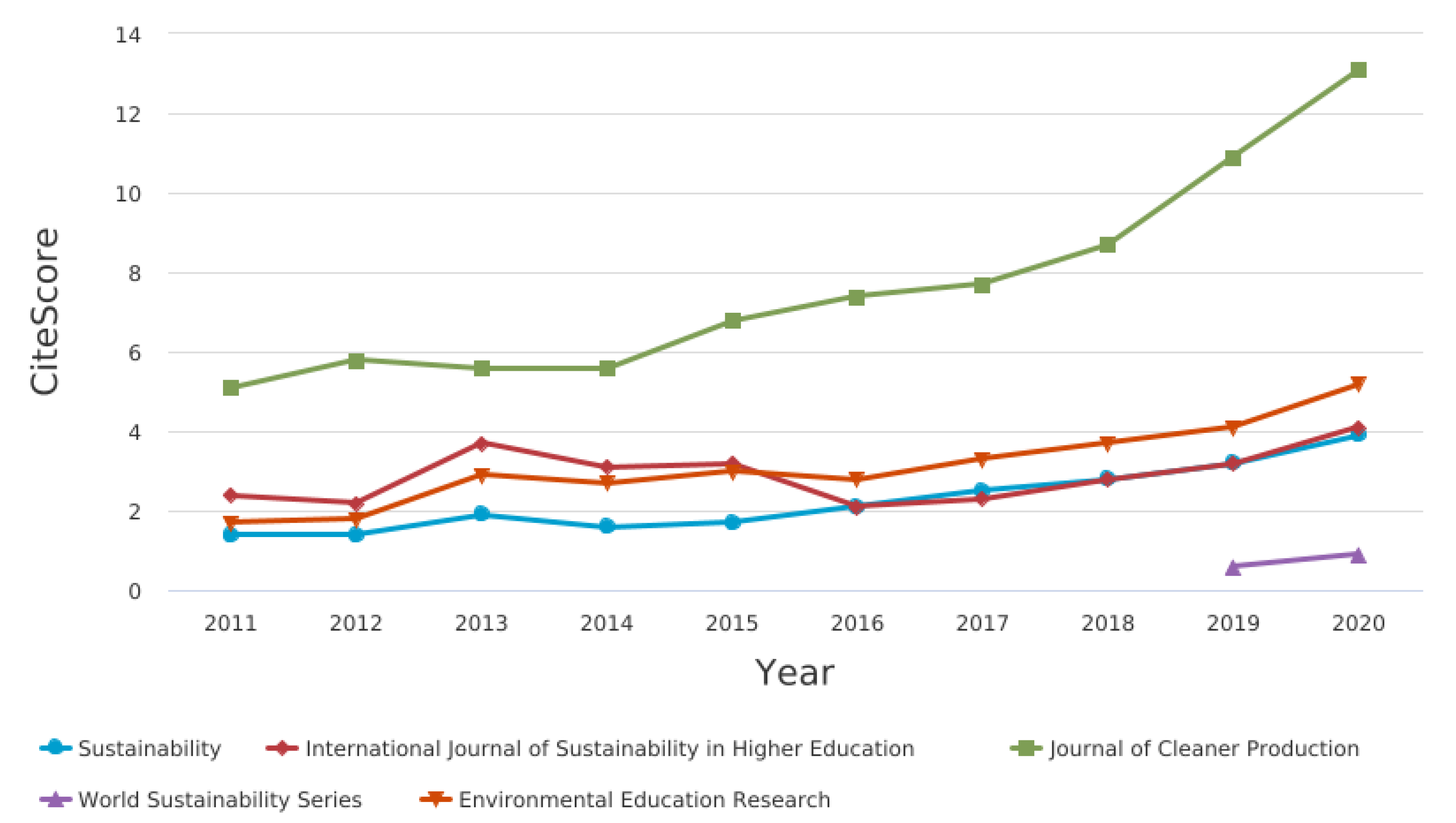
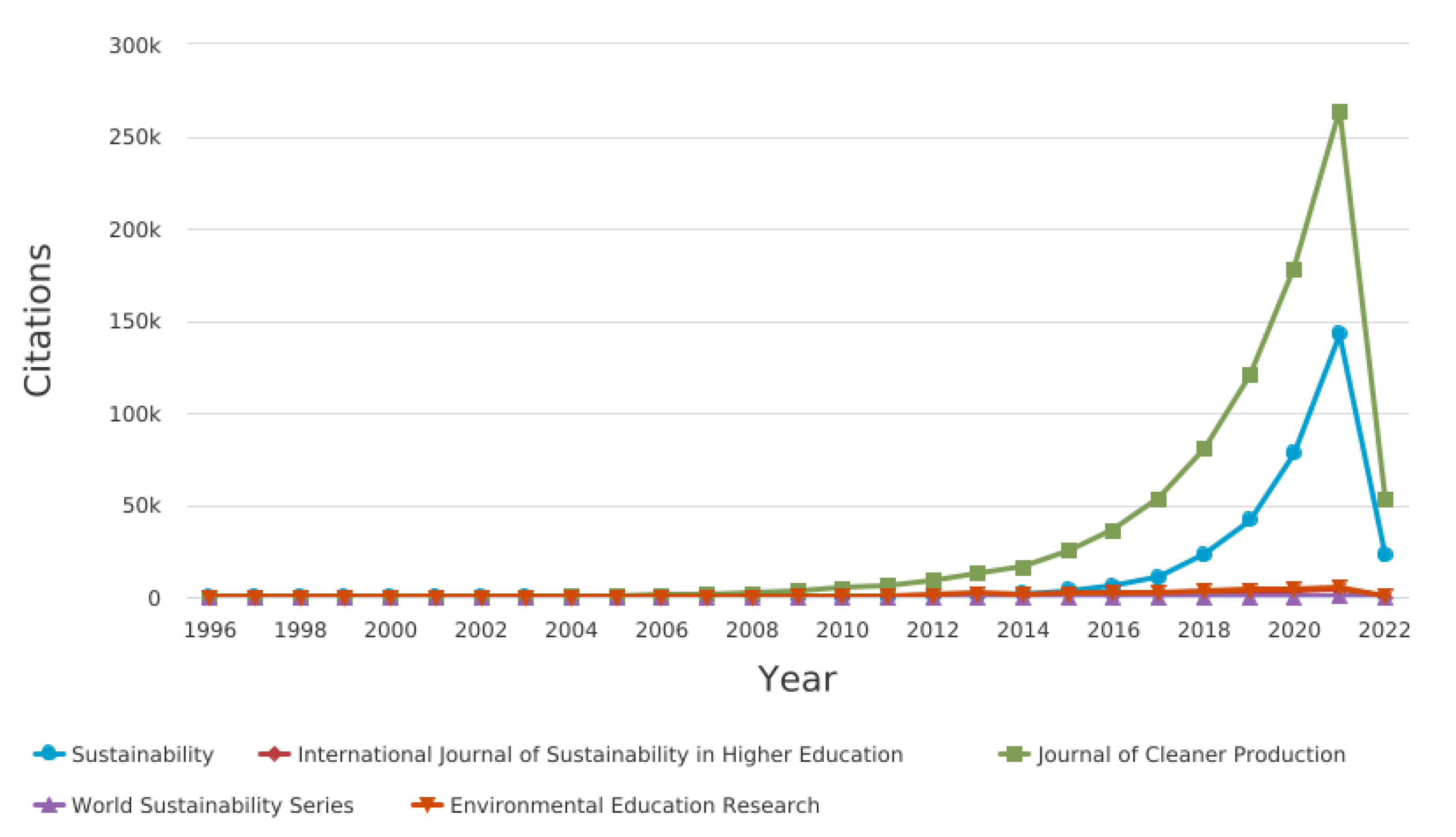
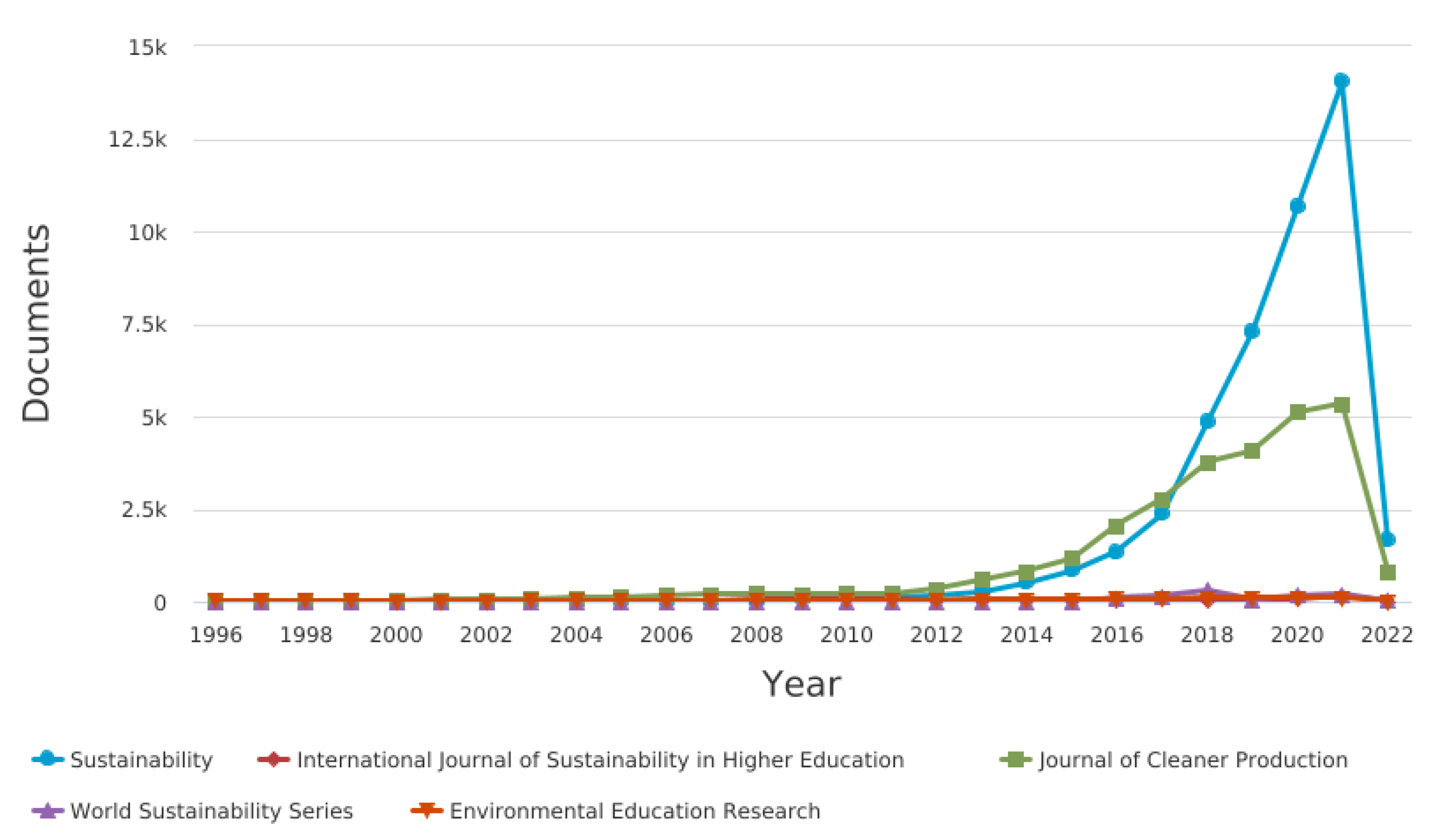
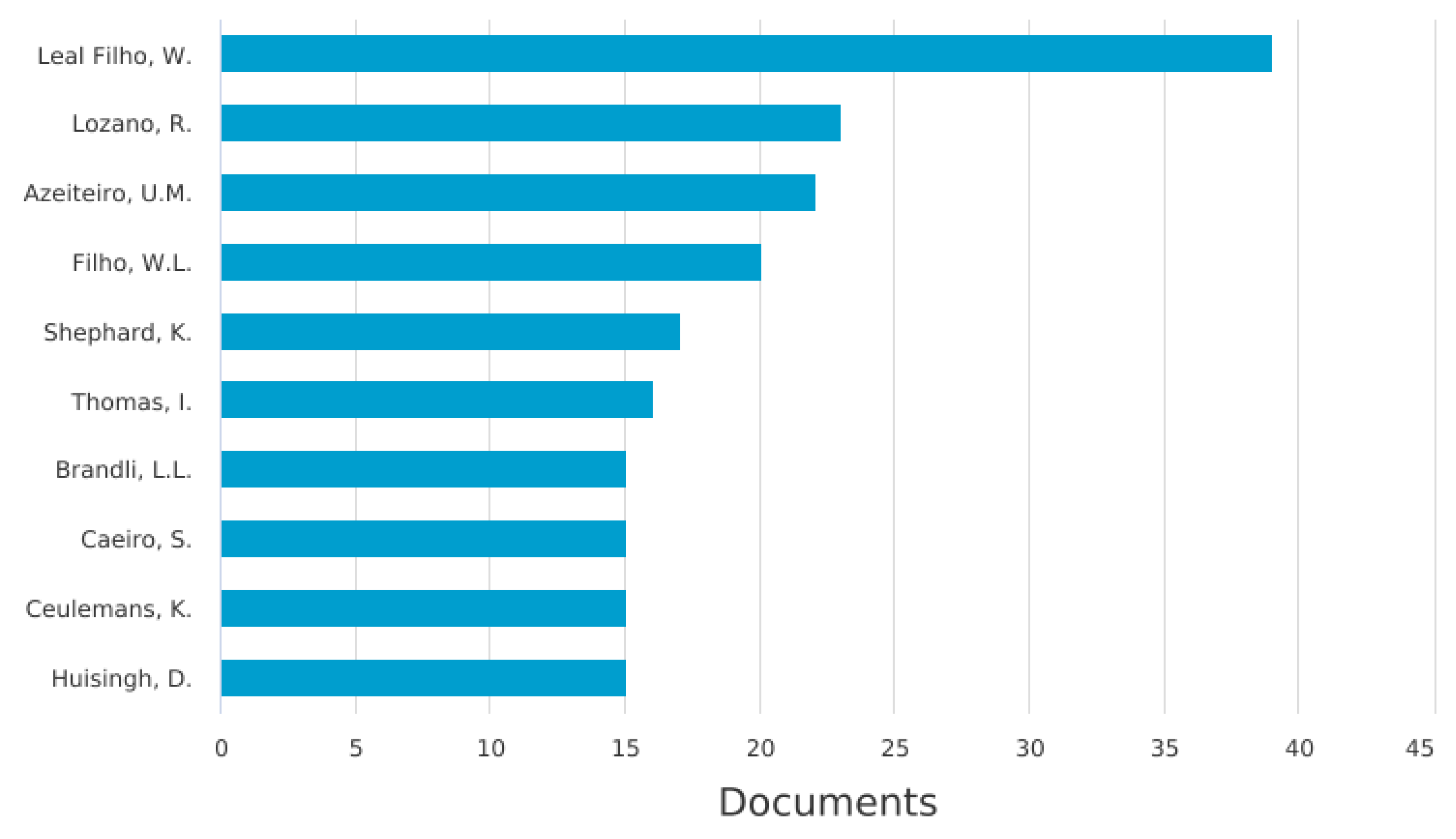
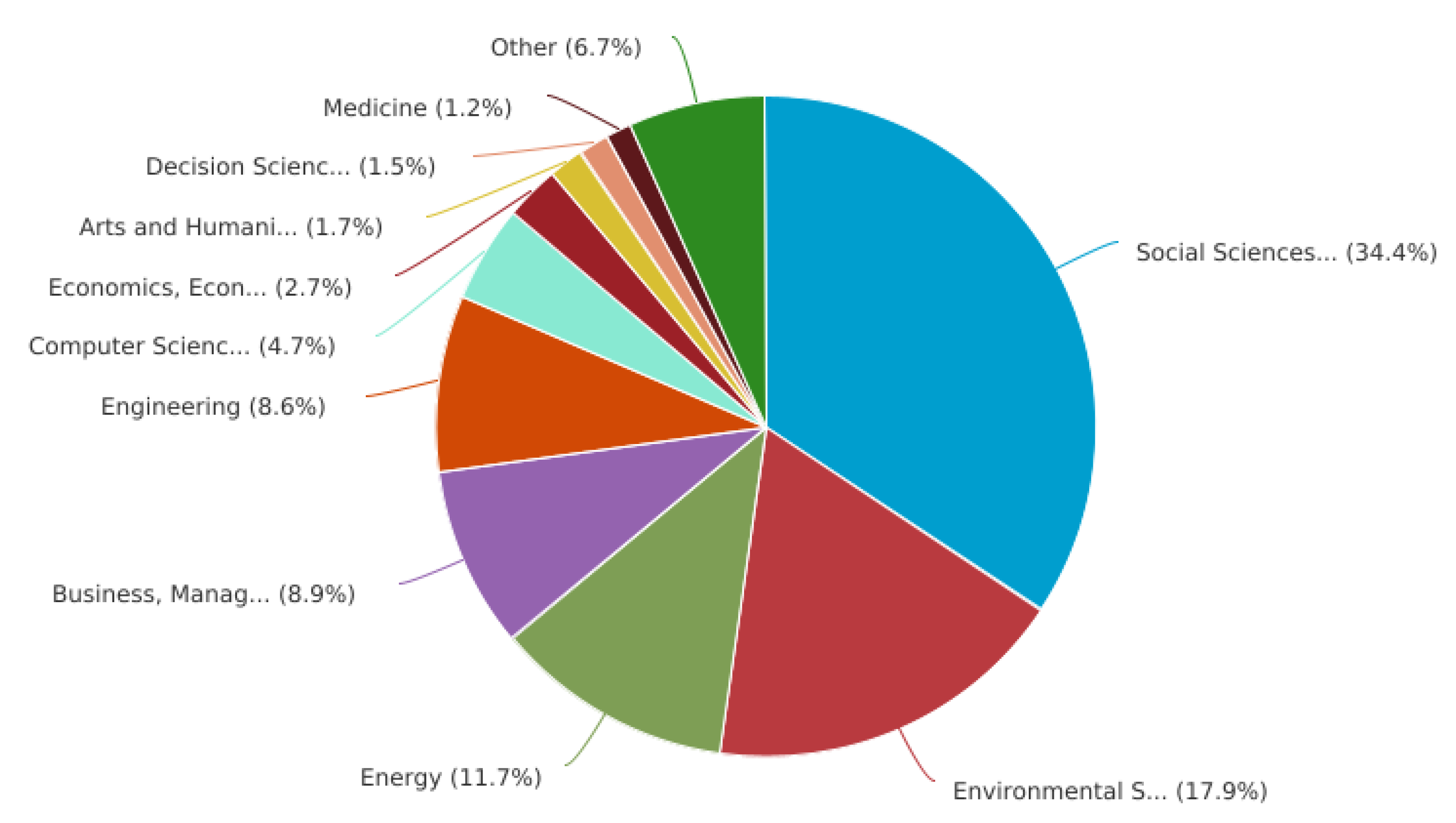
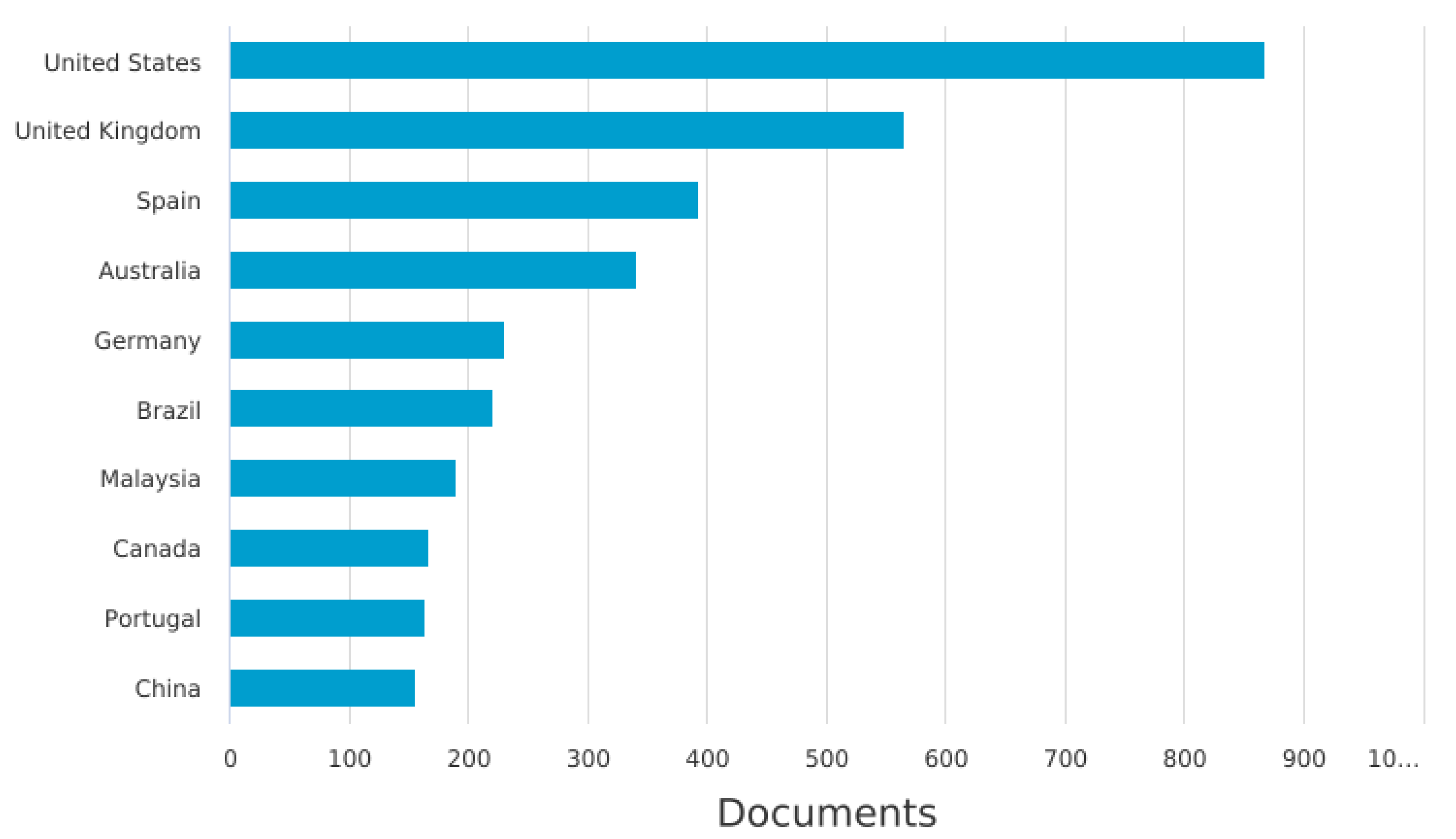
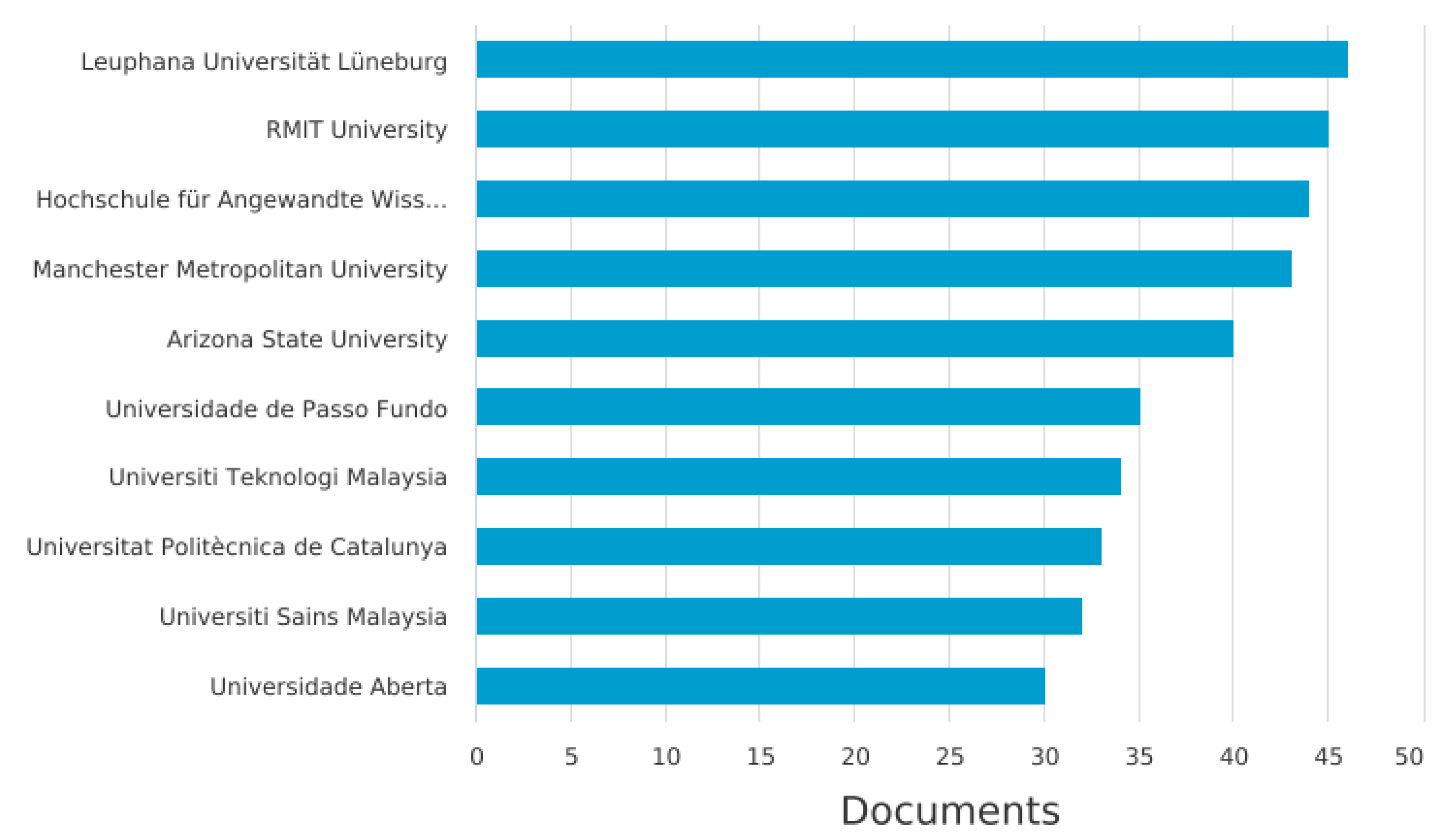
Publisher’s Note: MDPI stays neutral with regard to jurisdictional claims in published maps and institutional affiliations. |
© 2022 by the authors. Licensee MDPI, Basel, Switzerland. This article is an open access article distributed under the terms and conditions of the Creative Commons Attribution (CC BY) license (https://creativecommons.org/licenses/by/4.0/).
Share and Cite
Machado, C.F.; Davim, J.P. Higher Education for Sustainability: A Bibliometric Approach—What, Where and Who Is Doing Research in This Subject? Sustainability 2022, 14, 4482. https://doi.org/10.3390/su14084482
Machado CF, Davim JP. Higher Education for Sustainability: A Bibliometric Approach—What, Where and Who Is Doing Research in This Subject? Sustainability. 2022; 14(8):4482. https://doi.org/10.3390/su14084482
Chicago/Turabian StyleMachado, Carolina Feliciana, and João Paulo Davim. 2022. "Higher Education for Sustainability: A Bibliometric Approach—What, Where and Who Is Doing Research in This Subject?" Sustainability 14, no. 8: 4482. https://doi.org/10.3390/su14084482
APA StyleMachado, C. F., & Davim, J. P. (2022). Higher Education for Sustainability: A Bibliometric Approach—What, Where and Who Is Doing Research in This Subject? Sustainability, 14(8), 4482. https://doi.org/10.3390/su14084482






